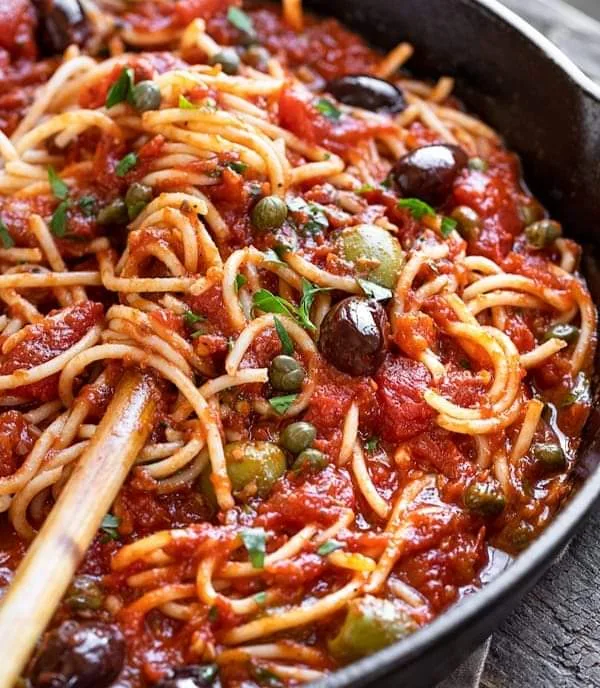Pasta Puttanesca recipe
Mildly spicy and deliciously aromatic, pasta puttanesca is a rich, savory pasta dish prepared very simply with a few pantry staples for a wonderfully rustic meal. Brimming with tomatoes, garlic, anchovies, capers, and briny olives tossed with warm spaghetti, this pasta puttanesca recipe is a classic Italian dish that's on the table in under 30 minutes!
Here's a glance at my pasta puttanesca recipe:
1. To begin, I place a large skillet over medium-high heat, and add in a generous pour of olive oil.
2. Next, I add the garlic to the skillet along with my minced anchovy fillets, and saute those together with some red pepper flakes until aromatic.
3. I add in my tomato products, followed by my capers and olives, as well as my dried herbs, and stir those to combine, allowing the puttanesca sauce to gently simmer, uncovered, for 20 minutes.
4. While the sauce simmers, I cook my spaghetti according to package instructions, then drain it and add it directly into my puttanesca sauce, and toss to combine.
5. To finish, I add in my fresh parsley, then serve in bowls with a bit of grated parmesan and basil leaves.
Ingredient
- Olive oil
- 8 cloves garlic, pressed through garlic press
- 8 anchovy fillets, lightly minced
- ½ to 1 teaspoon red pepper flakes (depending on desired spice level)
- 1 tablespoon tomato paste
- 1 (28 ounce) can whole tomatoes with juices, roughly chopped to chunky consistency
- 1 (14 ounce) can crushed tomatoes
- ½ cup pitted Castelvetrano olives
- ½ cup pitted Kalamata olives
- 2 tablespoons capers
- 1 teaspoon dried parsley
- ½ teaspoon dried oregano
- Salt
- Freshly ground black pepper
- 1 pound (16 ounce) package spaghetti pasta, or favorite pasta variety
- 2 tablespoons chopped, fresh parsley
- Basil leaves, optional garnish
- Shaved or grated parmesan, optional garnish.
Preparation
1. Begin by gathering and prepping all of your ingredients according to the ingredients list above to have ready and on organized for use.
2. Place a large skillet or Dutch oven over medium-high heat, and drizzle in about 1/ 4 cup of olive oil. Once hot, add in the garlic, minced anchovy fillets, and red pepper flakes, and stir to combine. Allow these to become aromatic, about 30 seconds to 1 minute.
3. Next, stir in the tomato paste to incorporate, followed by the roughly chopped whole tomatoes with juices, the crushed tomatoes, the Castelvetrano and Kalamata olives, the capers, and the dried parsley and oregano, and add a couple of pinches of salt and generous twist or two of freshly ground black pepper.
4. Allow the sauce to gently simmer, uncovered, for 20 minutes.
5. While the sauce simmer, cook your spaghetti (or other pasta) according to package instructions, then drain and keep warm.
6. To finish the pasta puttanesca, stir the fresh parsley into the sauce, then add the warm, cooked spaghetti directly into the sauce and gently toss with tongs to combine. Sprinkle over top some torn basil leaves (if using), and serve while hot, with parmesan if desired.
Tips for Pasta Puttanesca recipe:
1. Spaghetti, or your choice of pasta: Since spaghetti is a pretty traditional choice for pasta puttanesca, I opt for that here in my recipe. Not to mention, I happen to really love spaghetti. But other terrific options are angel hair (or vermicelli) pasta, or linguini, or even penne pasta.
2. Leave out the anchovies, if desired: If you're not a fan of anchovies, feel free to leave them out. I love that bit of richness and salty “umami” flavor that they add to this puttanesca sauce, giving it that something special that's not in traditional tomato sauces. They're not actually overwhelmingly strong, but if you'd rather not add 'em, feel free to omit.
3. Whole tomatoes, plus crushed tomatoes, for texture: I'm using a combination of good quality canned whole tomatoes and crushed tomatoes for the sauce. I roughly chop the whole tomatoes so that there's some chunky consistency to the puttanesca sauce, and appreciate the crushed tomatoes for their more velvety texture.
4. Two kinds of pitted olives, for briny flavor: Both Kalamata and Castelvetrano olives add a lot of briny flavor to this sauce, and I love the dual colors. But feel free to use just one of these types of olives, if you prefer. Make sure to opt for pitted, however, to avoid a toothache.

